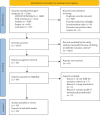Exploring the Impact of Biological Agents on Protecting Against Experimental Periodontitis: A Systematic Review of Animal-Based Studies
- PMID: 39654845
- PMCID: PMC11628168
- DOI: 10.1155/bmri/1716735
Exploring the Impact of Biological Agents on Protecting Against Experimental Periodontitis: A Systematic Review of Animal-Based Studies
Abstract
Aim: This systematic review was aimed at addressing the focused question: What is the protective potential of biological agents against alveolar bone resorption during the progression of experimental periodontitis (EP)? Material and Methods: The study protocol was registered in the Open Science Framework database (doi:10.17605/OSF.IO/3P2HY). A comprehensive literature search was conducted across PubMed, Web of Science, Cochrane Library, Scopus, and Embase databases up to December 2023. Inclusion criteria consisted of preclinical studies in animal models of EP that examined the effects of biological agents on preventing periodontal bone loss and reducing tissue inflammation. Studies were excluded if they (i) used non-EP animal models; (ii) focused on antimicrobial agents; (iii) centered on prebiotics or probiotics; (iv) evaluated compounds not classified as biologicals; or (v) included randomized clinical trials, clinical studies, or reviews. Eligibility was determined based on the PI/ECOs framework, and study quality was assessed using the SYRCLE risk-of-bias tool. Results: After screening an initial pool of 5236 records from databases, registries, and hand searches, 39 studies met the inclusion criteria. A total of 23 biological agents were evaluated across these studies. The majority of studies employed the ligature-induced model of EP to test the effectiveness of biologicals as preventive or therapeutic interventions. The dosage of biological agents and the duration of disease induction varied depending on the EP model. In all studies, the main outcome-alveolar bone loss, a hallmark of EP-was significantly inhibited by biological agents, which also reduced proinflammatory mediators when compared to untreated controls. A key strength of this review is the high number of studies included, most of which were classified as having low risk of bias. However, a notable limitation is the absence of a meta-analysis, the short follow-up periods in the included studies, and the heterogeneity among the compound dosages and route of administration. Conclusion: This systematic review demonstrates that biological agents are effective in reducing bone loss and mitigating inflammation during EP progression. Randomized clinical trials are needed to confirm these findings in human populations.
Keywords: alveolar bone; animal model; bone resorption; periodontal disease; periodontitis.
Copyright © 2024 Gabriela Ezequiel Oliveira et al.
Conflict of interest statement
The authors declare no conflicts of interest.
Figures


Similar articles
-
Systemic pharmacological treatments for chronic plaque psoriasis: a network meta-analysis.Cochrane Database Syst Rev. 2021 Apr 19;4(4):CD011535. doi: 10.1002/14651858.CD011535.pub4. Cochrane Database Syst Rev. 2021. Update in: Cochrane Database Syst Rev. 2022 May 23;5:CD011535. doi: 10.1002/14651858.CD011535.pub5. PMID: 33871055 Free PMC article. Updated.
-
Interventions for promoting habitual exercise in people living with and beyond cancer.Cochrane Database Syst Rev. 2018 Sep 19;9(9):CD010192. doi: 10.1002/14651858.CD010192.pub3. Cochrane Database Syst Rev. 2018. PMID: 30229557 Free PMC article.
-
Pre-operative endometrial thinning agents before endometrial destruction for heavy menstrual bleeding.Cochrane Database Syst Rev. 2013 Nov 15;2013(11):CD010241. doi: 10.1002/14651858.CD010241.pub2. Cochrane Database Syst Rev. 2013. PMID: 24234875 Free PMC article.
-
Guided tissue regeneration for periodontal infra-bony defects.Cochrane Database Syst Rev. 2006 Apr 19;(2):CD001724. doi: 10.1002/14651858.CD001724.pub2. Cochrane Database Syst Rev. 2006. Update in: Cochrane Database Syst Rev. 2019 May 29;5:CD001724. doi: 10.1002/14651858.CD001724.pub3. PMID: 16625546 Updated.
-
Local anti-infective therapy: pharmacological agents. A systematic review.Ann Periodontol. 2003 Dec;8(1):79-98. doi: 10.1902/annals.2003.8.1.79. Ann Periodontol. 2003. PMID: 14971250
Cited by
-
Healing with Love: Oxytocin Accelerates Oral Ulcer Recovery by Reducing Inflammation.J Clin Med. 2025 Apr 14;14(8):2667. doi: 10.3390/jcm14082667. J Clin Med. 2025. PMID: 40283497 Free PMC article.
-
Therapeutic Potential of Tanshinones in Osteolytic Diseases: From Molecular and Cellular Pathways to Preclinical Models.Dent J (Basel). 2025 Jul 9;13(7):309. doi: 10.3390/dj13070309. Dent J (Basel). 2025. PMID: 40710154 Free PMC article. Review.
References
-
- De Molon R. S., De Avila E. D., Cirelli J. A., Steffens J. P. Periodontal research contributions to basic sciences: from cell communication and host-parasite interactions to inflammation and bone biology. Biocell . 2022;46(3):633–638. doi: 10.32604/biocell.2022.018031. - DOI
Publication types
MeSH terms
Substances
LinkOut - more resources
Full Text Sources
Molecular Biology Databases
Research Materials
Miscellaneous

